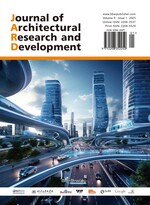Abstract
With the development of modern society, people put forward higher requirements for building safety, which makes the construction project face new challenges. Reinforced concrete frame structure as a common engineering type, although the construction technology has been relatively mature, but its earthquake collapse ability still needs to be strengthened. This paper analyzes the specific factors that affect the seismic collapse ability of reinforced concrete frame structure, summarizes the previous research results, and puts forward innovative application of fiber-reinforced polymer (FRP) composite materials, play the role of smart materials, improve the isolation and energy dissipation devices, etc., to promote the continuous optimization of reinforced concrete frame structure design, and show better seismic performance.
References
Jizhi S, Boquan L, Guohua X, et al., 2020, Influence of Beam-to-Column Linear Stiffness Ratio on Failure Mechanism of Reinforced Concrete Moment-Resisting Frame Structures. Advances in Civil Engineering, 2020(1): 1–24.
Chun Y, Hur M, 2015, Effects of Isolation Period Difference and Beam-Column Stiffness Ratio on the Dynamic Response of Reinforced Concrete Buildings. International Journal of Concrete Structures and Materials, 9(4): 439–451.
Chen L, Feng Y, 2012, Influence of Stiffness Zone on Seismic Performance of Reinforced Concrete Frame Structures. Industrial Building, 42(09): 75–78.
He L, Chong X, Sha H, et al., 2024, Research on Seismic Performance of Reinforced Concrete Frame Structure of External UHPC Curtain Wall with Different Connection Modes. Earthquake Research, 47(01): 94–104.
Sun J, Li B, Meng C, et al., 2019, Siding with Beam-Column Connection Mode Between the Structure Seismic Performance Influence [J]. Journal of Building Structures, 49(08): 16–21.
Cheng W, Song Y, Wang J, 2015, Experimental Study on Seismic Performance of Joints in Beams and Columns of Prefabricated Partial Steel-Reinforced Concrete Frames. Journal of Dalian University of Technology, 55(02): 171–178.
Nguyen SH, Tran QV, Nguyen HQ, 2019, Influence of Parameters Reinforced Concrete Floor to Stiffness of Beam—Columns Connector in Composite Structures. International Journal of Innovative Technology and Exploring Engineering (IJITEE), 8(10): 3071–3075.
Xu KM, 2012, Seismic Damage Analysis and Research on Seismic Measures of Reinforced Concrete Frame Structure Houses. Science and Technology Vision, 2012(17): 191–193.
Wang K, Lin J, Yang W, et al., 2017, Research Progress on Long-Term Properties and Durability of Reactive Powder Concrete. Concrete, 2017(11): 27–30 + 34.
Zheng S, Yang J, Zheng Y, et al., 2020, Review on Bond Slip Performance of Corroded Reinforced Concrete. Materials Review, 34(S2): 1221–1226.
Zhou J, 2016, Study on the Degradation of Bonding Properties of Corroded Reinforced Concrete Members. Housing and Real Estate, 2016(36): 290–291.
Wu X, 2023, Study on Influence of Construction Joint on Seismic Performance of Concrete Frame Structure. Jiangxi Building Materials, 2023(11): 339–340 + 345.
Zhang Y, Chen J, Du X, et al., 2015, Research on Material-Based Damage Model of Multi-Storey Reinforced Concrete Frame Structures. Building Structures, 45(06): 7–13.
Huang Haobo, 2024, Analysis and Optimization of Seismic Performance of Reinforced Concrete Frame Structures. Sichuan Cement, 2024(12): 64–66.
Zhang Y, 2019, Research on Construction Quality Management Countermeasures of Reinforced Concrete Frame Structure of Dormitory Building. Engineering Technology Research, 9(21): 153–155.
